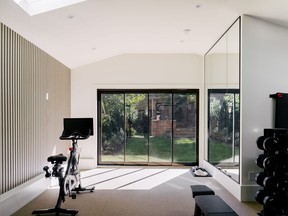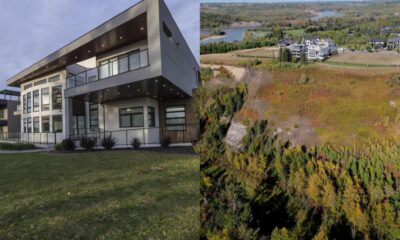Entertainment
Canadians Transform Homes into Wellness Retreats for Self-Care

Canadians are increasingly reimagining their homes to prioritize wellness, integrating self-care elements into their living spaces. Homeowners across the country are designing environments that promote relaxation and well-being, moving beyond mere aesthetics to create sanctuaries that enhance their quality of life.
Carmelle Sly, a resident of Edmonton, exemplifies this trend with her unique backyard design. Alongside her husband, Dan Sly, she has transformed their outdoor space into a mountain-like retreat, complete with a large fire cauldron and a variety of native plants. “Our backyard was built to be like a mountain oasis, with junipers, pussytoes and other native plants,” Sly states, emphasizing the importance of feeling connected to nature even in an urban environment.
This move towards wellness is not limited to outdoor spaces. Canadians are incorporating various self-care features throughout their homes. From cold plunge stations to spa-inspired bathrooms, these upgrades reflect a growing desire to create personal retreats. According to Evelynn Ratcliffe, a partner at custom builders Alair Homes, homeowners often start with physical improvements but ultimately seek health and well-being at the core of their renovations.
Creative Ways to Enhance Home Wellness
For those looking to enhance their homes without extensive renovations, Ratcliffe suggests simple upgrades. Smart lighting that adjusts to outdoor conditions can significantly improve the ambiance, making spaces feel lighter and more inviting. Pairing this with specialty shades to reduce glare can create a more harmonious environment that aligns with daily rhythms.
Homeowners are also finding innovative ways to carve out dedicated spaces for wellness. Cozy corners with comfortable chairs and mood lighting, glass walls to maximize views, and creative nooks for hobbies are all popular choices. A well-lit home painting studio, for instance, can blend art and relaxation, enriching the homeowner’s experience.
When considering return on investment, high-ticket items stand out. Features like cold plunges, saunas, and home gyms are in demand. “People want that spa-like feeling in the privacy of their home,” Ratcliffe explains. Having access to these amenities in a personal space allows for control over cleanliness and convenience, especially in a post-pandemic world.
The COVID-19 pandemic has shifted how Canadians view their homes, balancing the need for communal spaces with areas for solitude. Ratcliffe notes, “The pendulum has landed in the middle, where you have open concept areas that invite family togetherness alongside spaces for personal time.”
Designing for All Seasons
For those on a budget, Sly advises adding small touches that can greatly impact wellness. Inexpensive pops of color from frost-resistant perennials like day lilies can enhance outdoor spaces without significant expenses. Sly also emphasizes that thoughtful design is crucial during winter months. “Just because we live in a winter city doesn’t mean we can’t enjoy the winter-ness,” she asserts.
Creating warmth and comfort during colder seasons is essential. Flameless lanterns can illuminate outdoor spaces, while automated blinds can maximize natural light. Fireplaces that can be ignited with a switch provide easy warmth, encouraging homeowners to embrace the outdoors even when temperatures drop.
Ultimately, the focus on wellness in home design reflects a broader trend of valuing personal health and comfort. Canadians are not just building houses; they are creating environments that support well-being and foster a sense of peace and tranquility. As more individuals prioritize self-care, the home becomes a pivotal space for nurturing both body and mind.
-

 World4 months ago
World4 months agoScientists Unearth Ancient Antarctic Ice to Unlock Climate Secrets
-

 Entertainment4 months ago
Entertainment4 months agoTrump and McCormick to Announce $70 Billion Energy Investments
-

 Lifestyle4 months ago
Lifestyle4 months agoTransLink Launches Food Truck Program to Boost Revenue in Vancouver
-

 Science4 months ago
Science4 months agoFour Astronauts Return to Earth After International Space Station Mission
-

 Technology2 months ago
Technology2 months agoApple Notes Enhances Functionality with Markdown Support in macOS 26
-

 Top Stories3 weeks ago
Top Stories3 weeks agoUrgent Update: Fatal Crash on Highway 99 Claims Life of Pitt Meadows Man
-

 Sports4 months ago
Sports4 months agoSearch Underway for Missing Hunter Amid Hokkaido Bear Emergency
-

 Politics3 months ago
Politics3 months agoUkrainian Tennis Star Elina Svitolina Faces Death Threats Online
-

 Technology4 months ago
Technology4 months agoFrosthaven Launches Early Access on July 31, 2025
-

 Politics4 months ago
Politics4 months agoCarney Engages First Nations Leaders at Development Law Summit
-

 Entertainment4 months ago
Entertainment4 months agoCalgary Theatre Troupe Revives Magic at Winnipeg Fringe Festival
-

 Top Stories1 week ago
Top Stories1 week agoFamily Remembers Beverley Rowbotham 25 Years After Murder





















